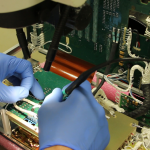In the last two decades, computers, mobile phones and other electronic devices have become lighter and smaller. It is a transformation that continues with the arrival of adaptable or flexible electronics, and signals an interesting future. Soon it will be possible to crumple up the keyboard and tuck it in the pocket. While some of the developments of this technology are still incomplete, don’t you think it’s the perfect time for the defense industry to prepare?
Let us briefly look at this technology, arguing why it is the present and future of defense.
Adaptable Electronics Borne Out of Stretchy Circuits
The intricate blend of components in the majority of today’s electronics has no room for bending. A good example is the typical processor in a silicon wafer that would snap if subjected to the smallest bend. Printed circuit boards with bending capability can change all that. Mobile phones and computers would bend and still remain functional.
Stretchy circuits are different from the typical ones. It all boils down to the constituent components. Designers combine liquid metals with flexible polymer to form metal-polymer conductors (MPCs). This is a huge diversion from the present metals like silver and copper, which are naturally solid. Stretchy circuits can assume any shape without losing their electrical conductivity.
It has been a long journey for this technology. From a stretching percentage of just 70% in 2008, stretchy circuits can today stretch by hundreds of times! Flexible electronics are now the future of defense and other industries because the circuits are not only more adaptable, but also thinner and smaller.
How the Defense Industry Can Benefit
The additional capabilities of adaptable electronics over conventional interconnect solutions suit the defense industry. This technology offers opportunities for reduced cost, better shock performance, superior high-speed signals and higher reliability. Adaptable electronics in defense provide a valuable shift in design approach. Rather than designing the components to adapt to the circuit, the circuit can be designed to suit the component. With that alone, space constraints previously experienced can be solved.
Here is a summary of notable benefits of adaptable electronics in defense:
Higher Reliability
- Less failure points
- Polyimide provides thermal stability
- Improved performance due to low mass and ductility
Reduced Weight
- 10% less weight on average
- Complete design weighs less
- Better drop test performance
Lower Cost
- Assembly is simple and less prone to errors
- Routing errors are reduced, hence fewer reworks and less test time
- Integrated design
Better High Speed Signal
- Consistent material thickness helps maintain impedance values
- Better for high density circuit routing
Some Applications in Defense
The defense industry can be a beneficiary of adaptable electronics in many ways. Three notable areas of application are displays, solar arrays, and sensors. Defense aircraft already have capability to embed sensors in the frames. This industry is therefore in a perfect position to adopt flexible sensors.
Defense personnel typically have to contend with logistical challenges of carrying fuels, sometimes over punishing terrains. Adaptable electronics give rise to flexible solar cells that the industry can optimize. Placed on structures such as halls or tents, these cells can generate electricity.
Still on logistics, the military is renowned for heavy combat gear. Electronic readers based on adaptable electronic technology would provide essential information and communicate securely. Attached to the uniform, such a device substantially reduces the load on the soldier.
Closing Remarks
The next few decades will see revolutionary technologies invade the global defense industry. Applying adaptable electronics is not only a technological necessity, but also a security strategy. As this technology improves, we can expect decision makers in defense to be ready for the impending transformations.
We would like to hear your views about defense applications of adaptable electronics. Reach us here as you sample our services.




